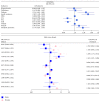Gender Disparity in the Relationship between Prevalence of Thyroid Nodules and Metabolic Syndrome Components: The SHDC-CDPC Community-Based Study
- PMID: 28607535
- PMCID: PMC5457761
- DOI: 10.1155/2017/8481049
Gender Disparity in the Relationship between Prevalence of Thyroid Nodules and Metabolic Syndrome Components: The SHDC-CDPC Community-Based Study
Abstract
The study is aimed to investigate the pathogenesis underlying the increased prevalence of thyroid nodule (TN) in different levels of metabolic syndrome (MetS) components and analyze the relationships between TN and MetS components. A total of 6,798 subjects, including 2201 patients with TN, were enrolled in this study. Anthropometric, biochemical, thyroid ultrasonographic, and other metabolic parameters were all measured. There was obviously sexual difference in the prevalence of TN (males 26.0%, females 38.5%, resp.). The prevalence of TN in hyperuricemia (45.7% versus 37.4%, P = 0.001), NAFLD (41.2% versus 36.4%, P < 0.05), and MetS (41.4% versus 35.4%, P < 0.001) groups was significantly increased only in females. Insulin resistance [OR = 1.31 (1.15, 1.49)], MetS [OR = 1.18 (1.03, 1.35)], and diabetes [OR = 1.25 (1.06, 1.48)] were all independent risk factors for TN in total subjects, whereas, after stratified analysis of gender, MetS [OR = 1.29, (1.09, 1.53)] and diabetes [OR = 1.47, (1.17, 1.84)] are still strongly and independently associated with the higher risks of TN in female subjects, but not in males. Our results suggest that the components of MetS might associate with the higher risks of TN in women than in men, but further cohort study of this gender disparity in the association between TN and MetS is required.
Figures

References
MeSH terms
LinkOut - more resources
Full Text Sources
Other Literature Sources
Medical

